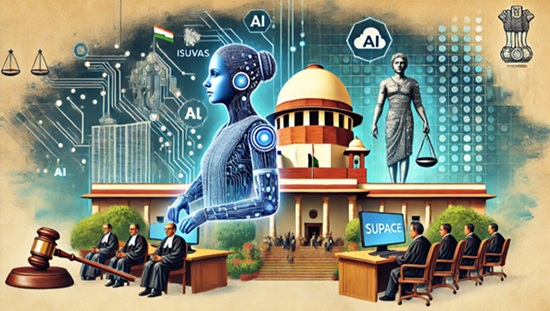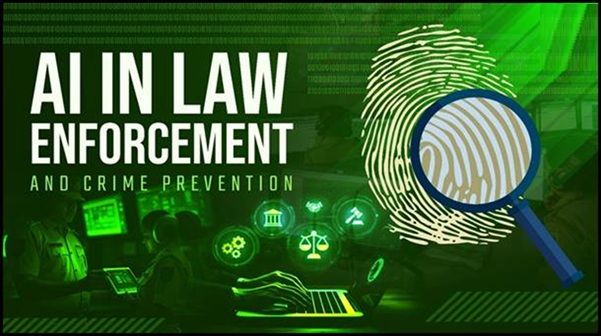Why discuss this ?
- In today’s digital era, Artificial Intelligence (AI) is no longer limited to technical and commercial domains.
- It is rapidly entering the fields of judiciary and law enforcement.
- Technologies like Machine Learning (ML), Natural Language Processing (NLP), Optical Character Recognition (OCR), and Predictive Analytics are being used for judicial processes, legal research, and law enforcement.

- AI can make the functioning of the judiciary more transparent, faster, and effective.
- Similarly, in law enforcement, AI assists in crime prevention, identifying criminals, and making investigation processes more scientific and accurate.
Importance:
Modernization of the Judiciary

- AI enhances the efficiency of judicial work.
- It accelerates the adoption of digital technologies and reduces the burden on human resources.
- In the third phase of e-Courts, extensive use of AI is observed, such as:
- Automated Case Management: Prioritizing cases and monitoring pending cases.
- Legal Research: Analyzing Supreme Court and High Court judgments.
- Prediction of Delays/Postponements: Estimating possible obstacles and reasons for pending cases.
- Case Analysis: Studying preliminary case documents and identifying potential outcomes.
Example: The SUPACE (Supreme Court Portal for Assistance in Courts Efficiency) portal helps judicial officers in decision-making by analyzing case filings and related data in the Supreme Court.
Translation of Legal Subjects and Digital Access
- AI-based translation software is used to ensure public access to all judicial documents and judgments.
- SUVAS (Supreme Court Legal Translation Software): Translates over 31,000 Supreme Court judgments into 16 languages.
- e-SCR Portal: Provides digital access to AI-translated judgments.
Thus, AI not only modernizes the judiciary but also makes access to justice easier for the public.
Law Enforcement and Crime Prevention
Predictive Policing
- AI helps law enforcement agencies predict crimes.
- By analyzing crime patterns, it can identify high-crime areas and potential offenders.
- This enables the police to prepare strategies based on forecasts.
AI-Powered Surveillance
- Drones and CCTV Monitoring – Real-time monitoring of crime scenes.
- Facial Recognition Systems – Applications like NAFRS (National Automated Facial Recognition System) developed by NCRB and ABHED (AI Based Human Face Detection) are used by Rajasthan and Punjab Police.
Digital Evidence and Forensic Analysis
AI-based forensic tools collect and analyze digital evidence from crime scenes.
- Voice Recognition Systems – Assist in filing FIRs.
- Augmented Reality (AR) – Digital reconstruction of crime scenes.
- Integration with National Systems – Systems like CCTNS, e-Jail, and e-Forensics integrate with AI to improve crime tracking and coordination among investigative agencies.
This way, AI makes law enforcement more scientific, faster, and efficient in less time.
Challenges in Adopting AI in Judiciary and Law Enforcement
Data Quality and Algorithmic Bias
AI models are only as good as the data they are trained on. Poor-quality or biased data can lead to unfair and unexpected outcomes.
- In Western countries, AI models have shown bias against Black people and women.
- In India, the digital divide may create barriers for remote and underprivileged communities in accessing justice.
Transparency and Black-Box Models
AI algorithms are often “black boxes,” meaning the reasoning behind their decisions is unclear.
- This can create legal challenges in judicial and policing decisions.
- Lack of transparency can reduce public trust.
Ethics, Law, and Privacy
AI usage raises questions about privacy rights and ethics.
- Lack of accountability.
- Risks due to unclear laws.
- Decisions based on incorrect data or models can lead to delays in justice and wrongful judgments.
Capacity and Resistance
Adopting AI also faces challenges due to technical expertise and funding constraints.
- Fear of job loss among officials and staff.
- Distrust of new technology.
- Need for investment in training and skill development.
Positive Impacts and Future of AI
Judicial Transparency and Effective Law Enforcement
AI not only enhances efficiency but also strengthens transparency and accountability in the justice system.
- Use of blockchain technology to securely maintain case records.
- Forecasting of pending cases and judgments through AI analytics.
- Prevention of digital crimes by enhancing cybersecurity.
Improvement in Legal Research
- Faster and more accurate access to case law and judgments for judges and lawyers.
- Rapid analysis of decisions across different languages and jurisdictions.
Crime Prevention and Predictive Analytics
- Effective policing through identification of criminals and crime-prone areas.
- Swift crime response using AI-based digital surveillance, forensic tools, and facial recognition systems.
Education and Training
AI can enhance efficiency by providing digital and technical training to judicial and law enforcement personnel.
Conclusion
The future of AI in the judiciary and law enforcement is extremely promising, but challenges exist. Ensuring data security, algorithmic transparency, ethics, and compliance with legal and social norms is critical.
Adopting AI can bring the following positive changes to India’s justice system:
- Increased Judicial Efficiency – Reduction in pending cases and faster case disposal.
- Equal Access to Justice – Multilingual translation of judgments for broader reach.
- Effectiveness in Law Enforcement – Crime prediction, faster investigation, and digital monitoring.
- Transparency and Accountability – Improvement in judicial decisions through AI analytics.
- Cybersecurity and Digital Evidence – Digital forensics and secure record-keeping.
Summary
AI has the potential to make judicial and law enforcement processes more transparent, fair, and timely. However, addressing challenges related to data security, ethics, transparency, and technical capability is essential. Overcoming these barriers could allow AI to revolutionize the Indian justice system and law enforcement.
|
Question: What is the SUPACE portal used for ?
(a) Monitoring criminals
(b) Case filing and data analysis
(c) Collection of digital evidence
(d) Multilingual translation of judicial orders
|


